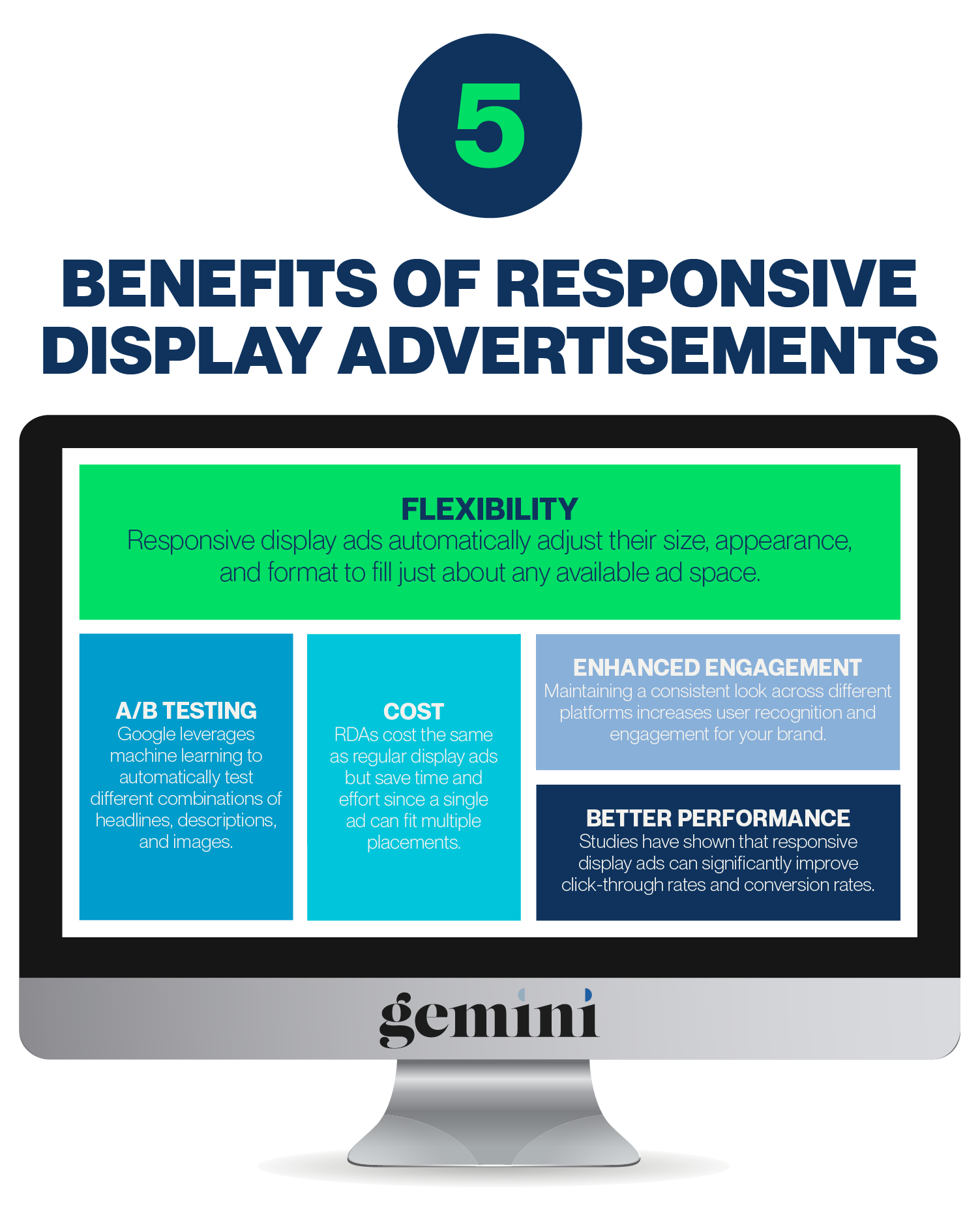Responsive Display Ads (RDAs) change how businesses target and engage audiences. By allowing Google to adjust the size, appearance, and format of your ads to fit available ad spaces, you can spread your message further and at a lower cost. What you sacrifice in control you gain in increased exposure.
In today’s fast-paced digital landscape, advertisers need dynamic solutions to reach customers wherever they are. Responsive display ads allow your message to appear more frequently and more effectively. Learn how responsive display ads work and how they can elevate your paid advertising efforts.
What is a Responsive Display Ad?
Responsive display ads are a cutting-edge form of digital advertising that automatically adapts to various screen sizes and devices. By using a single creative input, these ads fit any available ad space. This ensures a seamless and engaging experience for your users no matter what platforms they’re using.
To create a responsive ad, you upload the following elements to your Google Ads account:
- Visuals – Supply professional, eye-catching images to get your ad noticed.
- Headlines – Enter up to five H1s to pique curiosity and grab user interest.
- Description copy – Enter up to five, 90 character text descriptions. Make sure you include a call to action (CTA).
Once Google has these elements, it will mix and match them by using audience signals to determine which is most likely to get someone to engage. It’s a bit like an advertising slot machine with different results each time your ad appears.
What is the Difference Between a Responsive Display Ad and a Display Ad?
A responsive – or static – ad is one that you design and create on your own. You arrange the visual layout, compose and orient the text, and determine what size it should be. The net result is that you have complete control over the final appearance of your ad.
This control is beneficial in maintaining the integrity of your assets but you sacrifice in other areas. If you want a different layout or size, you need to create each ad individually. If you want to test and optimize your ads, you’ll need to set up multiple campaigns and track the engagement for each version.
5 Benefits of Responsive Display Ads

- Flexibility. The biggest advantage of using RDAs is their flexibility. Because responsive display ads automatically adjust to fill any available ad space, your ads look good on both desktop and mobile devices. This ensures that your users have a seamless experience wherever they search.
- Free, continuous A/B testing. Google’s responsive display ads leverage machine learning to automatically test different combinations of headlines, descriptions, and images. This enables the system to identify the best-performing ad combination for various placements and maximize your engagement and conversion rates based on their performance.:
- Cost-Effective: RDAs cost the same as regular display ads but save time and effort since a single ad can fit multiple placements.
- Enhanced Engagement: By providing a consistent look and feel across different platforms, responsive display ads can increase user recognition and engagement for your brand.
- Better Performance: Studies have shown that responsive display ads can significantly improve click-through rates and conversion rates. At Gemini we’ve seen as much as a 200% increase in clicks with clients using responsive ads.
4 Disadvantages of Responsive Ads
- No Creative Control: You have no input on which text and images go together.
- Unprofessional Appearance: By relinquishing creative control, you allow Google to create piecemeal ads that don’t look nearly as good as something a graphic designer might produce.
- Data Analysis: Google will report to you which ad combinations give the best ROI but you won’t know which combinations were actually displayed.
- Lack of Branding: Your ads will look the same as every other responsive display ad on the page. This can make it more difficult to stand out.
When Should You Use Responsive Display Ads?
Include responsive display ads in any type of digital ad campaign. The price and flexibility they offer is well worth the investment. You have clicks and conversions to gain and very little to lose.
The key to succeeding with a responsive ad campaign is to test your ad components before you send them. Make sure that the assets you provide Google – the images and text – will combine effectively without your input.
As your campaign begins to show results, track which ads are most effective. By analyzing which ads users interact with most, you can optimize your messaging across all of your channels.
Boost Your Google Ad Campaigns
Designing and executing a successful ad campaign takes time and focus. Subtle tweaks can yield big results. Trust your ads with a creative and data-focused team that stays on top of trends and adapts to Google’s ever-changing ad platforms. Gemini’s paid media team can help your business maximize its spend with ads that get better results. Contact us today!